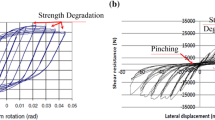Abstract
Many material and mechanical systems, such as magnetorheological (MR) dampers used for reducing vibration in engineering systems, have long-standing modeling and control problems because of their nonlinear hysteresis behavior. Existing hysteresis models, including discontinuous and piecewise-continuous functions, are nonideal for numerical computation, stability analysis, and control design. This study links the hysteresis characteristics of a Duffing-like equation and an input–output system through a very subtle observation. Thus, the hysteresis dynamics are approximated using a traceable, second-order nonlinear ordinary differential equation with an inertial element. In addition, the hysteresis stability associated with energy dissipation can be analyzed using the Lyapunov method in a more deterministic and systematic manner than has previously been possible. Experimental work and hysteresis identification of a realistic MR damper device are presented to illustrate the proposed Duffing-like modeling techniques.









Similar content being viewed by others
References
Spencer, B.F., Jr., Dyke, S.J., Sain, M.K., Carlson, J.D.: Phenomenological model for magnetorheological dampers. J. Eng. Mech. 123(3), 230–238 (1997). doi:10.1061/(asce)0733-9399(1997)123:3(230)
Wang, D.H., Liao, W.H.: Magnetorheological fluid dampers: a review of parametric modelling. Smart Mater. Struct. 20(2), 023001 (2011)
Dimock, G.A., Lindler, J.E., Wereley, N.M.: Bingham biplastic analysis of shear thinning and thickening in magnetorheological dampers. Proceedings of SPIE 3985, Smart Structures and Materials 2000: Smart Structures and Integrated Systems, 444. (2000)
Wereley, N.M., Pang, L., Kamath, G.M.: Idealized hysteresis modeling of electrorheological and magnetorheological dampers. J. Intell. Mater. Syst. Struct. 9(8), 642–649 (1998). doi:10.1177/1045389x9800900810
Nakashima, M.: Development, potential, and limitations of real-time online (pseudo-dynamic) testing. Philos. Trans. R. Soc. Lond. Ser. A Math. Phys. Eng. Sci. 359(1786), 1851–1867 (2001). doi:10.1098/rsta.2001.0876
Dyke, S.J., Spencer, B.F., Sain, M.K., Carlson, J.D.: Modeling and control of magnetorheological dampers for seismic response reduction. Smart Mater. Struct. 5(5), 565–575 (1996). doi:10.1088/0964-1726/5/5/006
Ikhouane, F., Rodellar, J.: Systems with Hysteresis Analysis, Identification and Control Using the Bouc-Wen Model. John Wiley and Sons, Chichester (2007)
Caterino, N., Spizzuoco, M., Occhiuzzi, A.: Understanding and modelling the physical behaviour of magnetorheological dampers for seismic structural control. Smart Mater. Struct. 20(6), 065013 (2011)
Yang, G., Spencer, B., Jung, H., Carlson, J.: Dynamic modeling of large-scale magnetorheological damper systems for civil engineering applications. J. Eng. Mech. 130(9), 1107–1114 (2004). doi:10.1061/(ASCE)0733-9399(2004)130:9(1107)
Tusset, A., Balthazar, J.: On the chaotic suppression of both ideal and non-ideal duffing based vibrating systems, using a magnetorheological damper. Differ. Equ. Dyn. Syst. 21(1–2), 105–121 (2013). doi:10.1007/s12591-012-0128-4
Ikhouane, F., Rodellar, J.: On the hysteretic Bouc-Wen model. Nonlinear Dyn. 42(1), 63–78 (2005). doi:10.1007/s11071-005-0069-3
Cetin, S., Zergeroglu, E., Sivrioglu, S., Yuksek, I.: A new semiactive nonlinear adaptive controller for structures using MR damper: Design and experimental validation. Nonlinear Dyn. 66(4), 731–743 (2011). doi:10.1007/s11071-011-9946-0
Sims, N.D., Holmes, N.J., Stanway, R.: A unified modelling and model updating procedure for electrorheological and magnetorheological vibration dampers. Smart Mater. Struct. 13(1), 100 (2004)
Jiang, Z., Christenson, R.E.: A fully dynamic magneto-rheological fluid damper model. Smart Mater. Struct. 21(6), 065002 (2012)
Visintin, A.: Differential Models of Hysteresis. Springer, Berlin (1994)
Duffing, G.: Erzwungene Schwingungen bei veränderlicher Eigenfrequenz und ihre Technische Bedeutung. R, Vieweg & Sohn, (1918)
Korsch, H.J., Jodl, H.-J., Hartmann, T.: Chaos: A Program Collection for the PC. Springer, Berlin (2008)
Hu, H., Dowell, E., Virgin, L.: Resonances of a harmonically forced Duffing oscillator with time delay state feedback. Nonlinear Dyn. 15(4), 311–327 (1998). doi:10.1023/A:1008278526811
Kovacic, I., Rand, R.: About a class of nonlinear oscillators with amplitude-independent frequency. Nonlinear Dyn. 74(1–2), 455–465 (2013). doi:10.1007/s11071-013-0982-9
Moon, F.C., Holmes, P.J.: A magnetoelastic strange attractor. J. Sound Vib. 65(2), 275–296 (1979). doi:10.1016/0022-460X(79)90520-0
Pandey, M., Rand, R., Zehnder, A.: Frequency locking in a forced Mathieu-van der Pol-Duffing system. Nonlinear Dyn. 54(1–2), 3–12 (2008). doi:10.1007/s11071-007-9238-x
Slotine, J.-J.E., Li, W.: Applied Nonlinear Control. Pearson Education, Taiwan (2005)
Tu, J.-Y., Chen, T.-C., Lin, P.-Y.: Using Duffing equation to model magnetorheological damper dynamics. In: The 6th world conference on structural control and monitoring, Barcelona, Spain, 15–17 July (2014)
Acknowledgments
The authors gratefully acknowledge the support of the Taiwan Ministry of Science and Technology, under grant 102-2625-M-007-001- ‘Development and Application of Model-Reference Semi-Active Control Methods for Magnetorheological Damper’, and National Center for Research on Earthquake Engineering, for the support in the pursuance of this work.
Author information
Authors and Affiliations
Corresponding author
Rights and permissions
About this article
Cite this article
Tu, JY., Lin, PY. & Cheng, TY. Continuous hysteresis model using Duffing-like equation. Nonlinear Dyn 80, 1039–1049 (2015). https://doi.org/10.1007/s11071-015-1926-3
Received:
Accepted:
Published:
Issue Date:
DOI: https://doi.org/10.1007/s11071-015-1926-3




